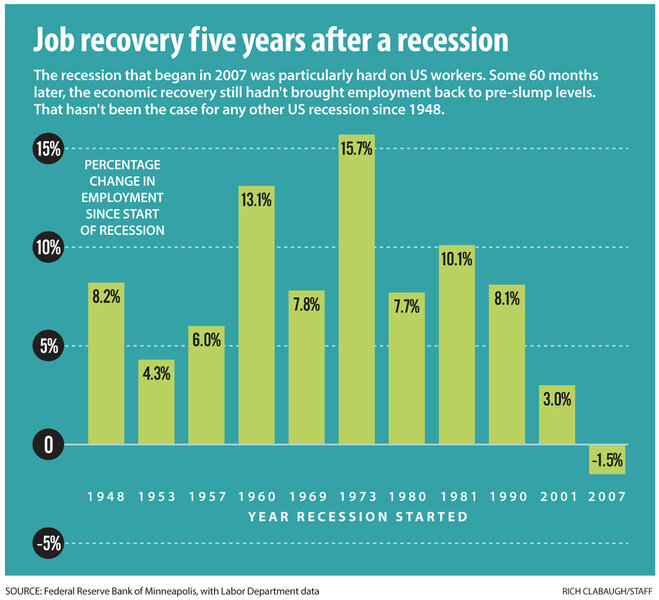Five years after Lehman bankruptcy: Will we see the next crisis coming?
Loading...
| Washington
“Never again." That might be the unofficial motto for a group of US regulators who meet regularly to keep a collective watch on the health of the financial system, some five years after a devastating crisis threw the economy into a tailspin.
Back on Sept. 15, 2008, when the investment bank Lehman Brothers filed for bankruptcy, nothing like this group existed.
Today, even with the body known as the Financial Stability Oversight Council in place, the idea of totally preventing the kind of panic that engulfed the world economy five years ago is a tall order – some say an impossible goal.
Yet finance experts also say that broader oversight of financial markets can help to make financial crises less frequent and less severe – and to create a system that's more capable of withstanding shocks when they do occur.
In the lead-up to the crisis of 2008, regulatory agencies each had their own sphere of supervision – such as banking, securities dealing, or (at the state level) insurance. A big-picture view was lacking. Some people thought about how all the pieces connected, but no one had both the responsibility and tools to thoroughly monitor potential risks across the whole system.
"Our regulatory structure was not set up really to do that," says Richard Berner, director of the federal Office of Financial Research, and a nonvoting member of the oversight council. "Each regulator was charged with regulating different parts of the financial system, and for different purposes."
It's not that no one saw problems. The bursting of a housing bubble and the ensuing losses for investors in "subprime" mortgages made the risks of real estate investments fairly plain for all to see. And by the middle of 2008, Lehman Brothers was widely regarded as an investment bank with lots of trouble embedded in its portfolio.
But to regulators and economists, it wasn't easy to see all the interconnections among financial firms, or how the problems in US real estate would ripple outward to threaten the larger economy in America and worldwide.
Ben Bernanke, who as Federal Reserve chairman sits on the Financial Stability Oversight Council (FSOC), has put it this way: "Prospective subprime losses were clearly not large enough on their own to account for the magnitude of the crisis.”
The crisis widened in good measure via a channel known as the "repo" market, short for "repurchase agreements," by which one financial institution extends short-term credit to another. Firms on the lending side of these deals began seeing greater risks that borrowers would default.
In effect, money dried up in a kind of moder bank run. The squeeze grew to its peak proportions after Lehman Brothers filed for bankruptcy.
Amplifying the problems was a dearth of good data. Which firms were at risk of bankruptcy? How big would losses get?
Soon, the mayhem in credit markets was causing layoffs and a loss of confidence in all corners of the economy.
It took a massive financial-aid effort by the government to calm financial markets and end a deep recession.
Then came the question of how to avoid a repeat, if possible.
The FSOC is just one of the mechanisms, embedded in the 2010 Dodd-Frank reform act, that aims to reach that goal.
Other provisions in the Dodd-Frank law seek to make banking firms stronger – by requiring more capital on hand as a cushion against potential losses. And the law seeks to make investors and chief executive officers more wary of risks, by calling for an end of bailouts when giant financial companies get into trouble.
The FSOC is another important line of defense.
The council was created to fill regulatory gaps, and to get various regulators together to watch the financial system. And the council can coordinate responses to threats.
The Office of Financial Research, created by Dodd-Frank within the Treasury Department, aids this effort by gathering data that used to go missing.
Is the effort working? In a recent interview, Mr. Berner offers a mixed report card on the effort to monitor a financial system that goes far beyond traditional banks to include hedge funds and trading in complex "derivative" securities.
"We've made a good start. But it's only a start,” he says.
Another Treasury official points to some of the progress that's been made since the crisis.
"On many metrics the banks look like they're a lot stronger and healthier than they were before," says Cyrus Amir-Mokri, the department's assistant secretary for financial institutions. Banks have much more capital, he says, and "numbers like net-charge-offs [of bad loans] are decreasing."
The incidence of outright failure among banks has fallen sharply.
"But I think the key thing to remember is, from a regulator's point of view, you have to remain vigilant," Mr. Amir-Mokri says. "The job of financial stability is really just to be on the watch all the time, regardless of how people think things are going."
Mr. Bernanke at the Fed, for one, thinks that's a good idea. In a speech this summer surveying some ups and downs of the central bank's 100-year history, he suggested that a "long period of calm" before the crisis to some extent "lulled investors, financial firms, and financial regulators into paying insufficient attention to building risks."
His conclusion: Regulators and Fed policymakers need to view maintaining a stable financial system as Job 1. If they fail on that front, it can do big damage to economy.








